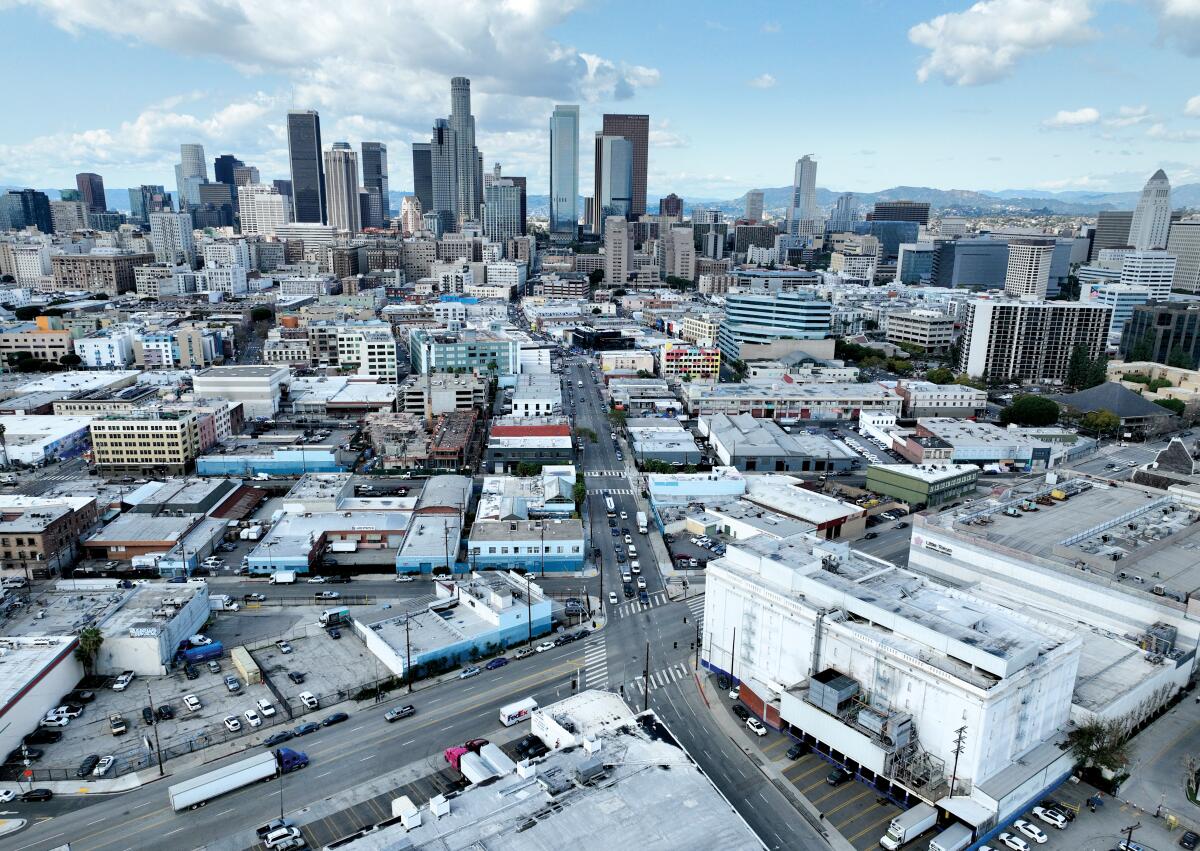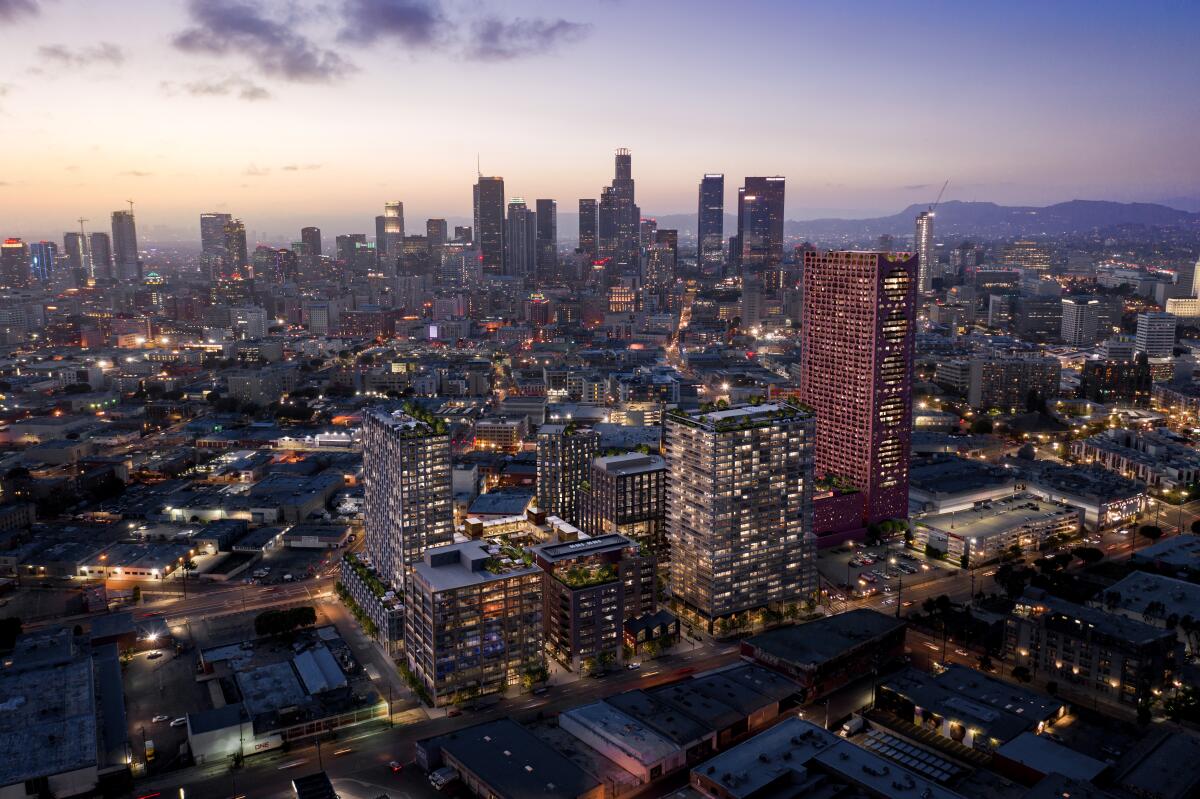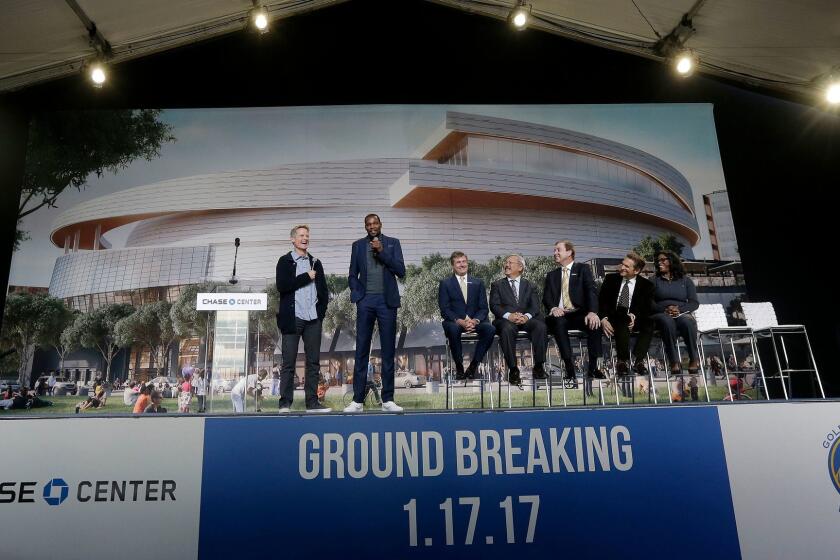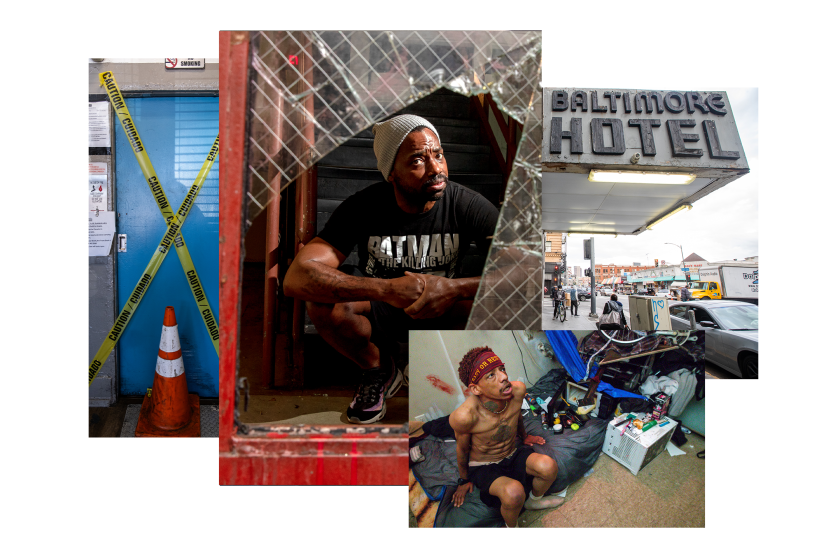$2-billion downtown L.A. mega-project gets boost from governor’s office, hopes for approval in 2024

- Share via
Gov. Gavin Newsom will attempt to expedite construction of a $2-billion residential and commercial mega-development in downtown Los Angeles, his administration announced Thursday.
The 7.6-acre project, named Fourth & Central, would bring 1,500 new homes, 410,000 square feet of office space along with retail, restaurants and a 68-room hotel to what’s now a collection of cold storage facilities, parking lots and warehouses in Skid Row near its boundary with the Arts District. Newsom’s decision Thursday aims to shave years off the construction timeline by fast-tracking a judicial decision in any litigation filed against the project under state environmental laws.
“For decades, we’ve let red tape stand in the way of these kinds of critical housing projects — and the consequences are in plain view all around us,” Newsom said in a statement. “Now we’re using California’s infrastructure law to build more housing, faster.”
Denver-based developers Continuum Partners unveiled the project in 2021. It’s made up of 10 buildings, including a 44-story residential skyscraper at Central Avenue and 4th Street. In total, the proposal calls for 572 condominiums and 949 apartments, with at least 214 units set aside as low-income housing.
A cold storage plant in Los Angeles’ Arts District would be replaced with housing, offices, a hotel and shops in a proposed mega-development called Fourth & Central.
Two marquee buildings including the high-rise were designed by Ghanaian-British architect David Adjaye, best known as the lead designer of the National Museum of African American History & Culture in Washington. The developer is partnering with Los Angeles Cold Storage Co., which has been operating on the site since 1895 and has provided refrigerated warehousing to many of the produce markets, hotels and buildings in the region.
Edgar Khalatian, an attorney with the firm Mayer Brown that is representing Continuum, called Fourth & Central a “transformative” project for Los Angeles, highlighting the plan to bring lots more housing and jobs to core neighborhoods.
“Housing folks at all income levels near transit and job centers should be all municipalities’ vision,” Khalatian said.
Thursday’s decision is one of multiple announcements this week that show the project’s timeline is ramping up. On Tuesday, Continuum publicized an agreement with the Los Angeles/Orange Counties Building and Construction Trades Council, an umbrella group of construction worker unions, to build Fourth & Central with all union labor, including requirements that workers be hired locally. Newsom’s office estimated that the project would create as many as 10,000 construction jobs.
The project still requires approval from the Los Angeles City Council, which Khalatian said the developer is hoping for by the end of the year. Construction would follow next year and take five to seven years to complete, he said.
It took until the morning the Golden State Warriors broke ground on their new professional basketball arena in San Francisco last week for the lawsuits against the project to end.
The expedited litigation timeline does not exempt the project from analysis under the California Environmental Quality Act, or CEQA, the 1970 law that requires developers to identify and, if possible, eliminate negative environmental effects.
However, it would shorten the length of any potential lawsuit against the project. Litigation under CEQA has long been blamed for killing or dragging out construction, especially for large developments. Thursday’s action aims to wrap up litigation within nine months instead of what’s typically three to five years.
Khalatian said the rules will provide major benefits for Continuum in terms of cost savings and development certainty while not diminishing the rights of possible opponents.
“There’s really nothing negative for anybody except for a petitioner, and even for a petitioner it’s just their lawyer has to work weekends,” he said.

There are expected to be challenges to the project, environmental or otherwise. Residents and activists in Skid Row and nearby Little Tokyo have long been concerned about gentrification as Arts District development has marched west.
The project’s website advertises Fourth & Central as “the New Gateway to DTLA.” A map on the site doesn’t mention Skid Row, instead prominently featuring the Arts District and referring to the surrounding area as the Fashion and Toy districts.
Multiple organizations in Little Tokyo have been tracking Fourth & Central through its planning and environmental applications and are worried about its potential to exacerbate displacement of low-income residents and erode the neighborhood’s role as the historic center of the region’s Japanese community.
“There is a desire that this project be part of the community and hope that we can figure something out,” said Grant Sunoo, director of community building and engagement at the Little Tokyo Service Center, a nonprofit social service and community development organization. “There’s skepticism as to whether it’s possible. It’s not just Little Tokyo that’s impacted, it’s these other neighborhoods too, especially Skid Row.”
Recently, The Times has been investigating Skid Row’s troubled housing providers, digging into the failures of nonprofits such as AIDS Healthcare Foundation.
Khalatian, the attorney representing Continuum, said Fourth & Central is in line with the city’s recently approved blueprint for downtown development and will add to the area’s existing fabric.
“We’re building a project that has multiple access points into the community, that’s built outwards toward the surrounding community and that’s near transit with significant affordable housing,” Khalatian said.
Fourth & Central is the third development to receive the governor’s approval to fast-track its CEQA litigation in recent months, following the proposed Sites Reservoir in the Sacramento Valley and a renewable energy project in Riverside.
Efforts to streamline environmental lawsuits for mega-developments go back to 2011 when then-Gov. Jerry Brown signed legislation implementing the plan as a job creation strategy during the Great Recession. The process does not guarantee that projects get built. Multiple sports stadiums including the Farmers Field football proposal at the Los Angeles Convention Center have received the benefit but never broke ground.
Last year, owners of 8150 Sunset, a Frank Gehry-designed residential and commercial skyscraper along the eastern edge of the Sunset Strip that qualified in 2014, put the site up for sale without commencing development.
Times staff writer Roger Vincent contributed to this report.
More to Read
Sign up for Essential California
The most important California stories and recommendations in your inbox every morning.
You may occasionally receive promotional content from the Los Angeles Times.









